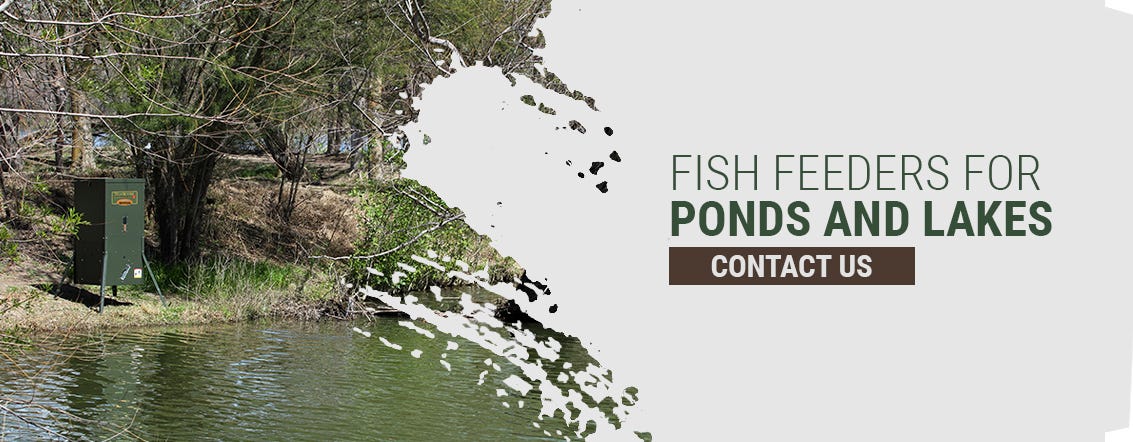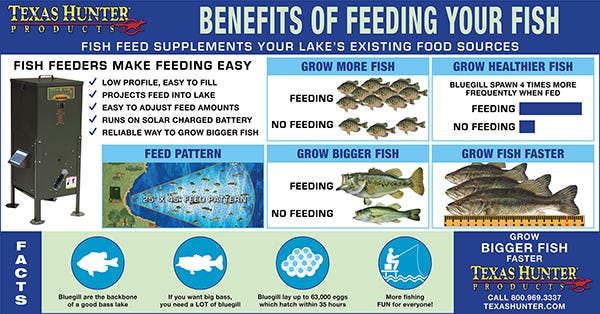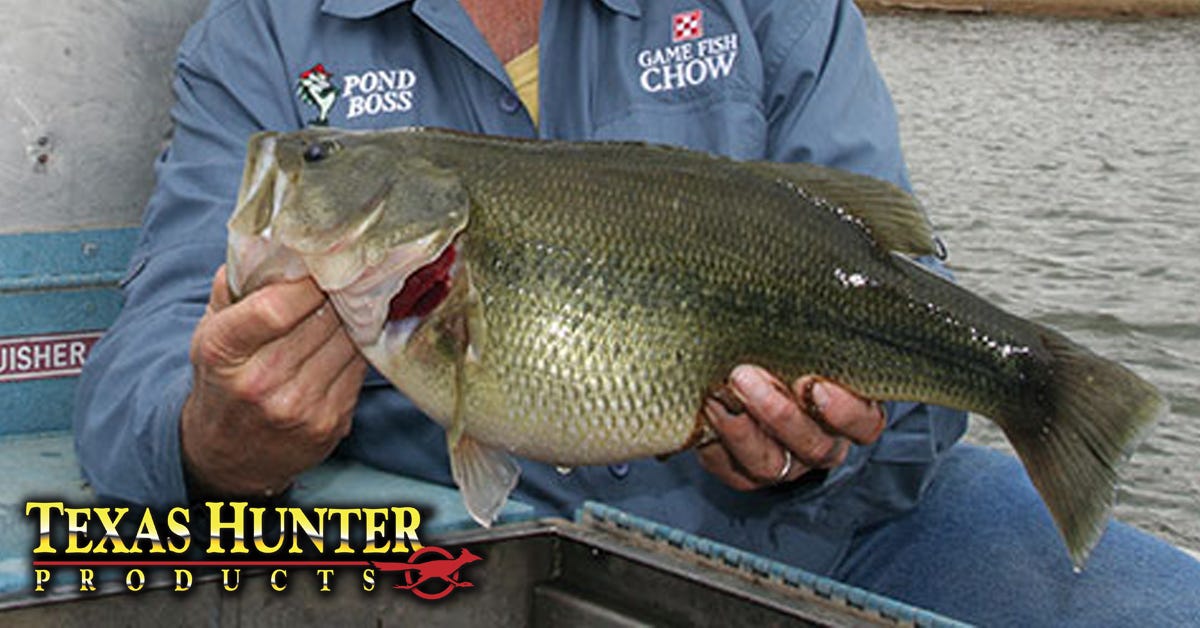- May 5, 2020
Pond Stocking Basics

A properly stocked and maintained pond or lake on your property offers the opportunity for countless hours of fishing and great memories with family and friends. A well-managed pond can also benefit the ecology of the area around it. However, correctly stocking a pond requires an understanding of environmental and maintenance factors that influence its vitality.
Knowing which fish species you should and should not introduce into your pond, as well as integrating the right size of fish feeders and habitats into the water, will all ultimately impact the enjoyment you get from fishing in your private pond. Let's identify some considerations all pond owners should take into account, including how to stock a pond with fish, how to properly maintain your pond and how to harvest your stocked fish.
How Do You Stock Your Pond With Fish?

Every pond is different. Factors like size, location and cost will vary. Generally, the best fish to stock a small pond with are those that are well-suited to your climate, recreational fishing and that create a balanced ecosystem. A 3-to-1 prey-to-predator ratio is ideal, as this will maintain consistent population levels and will help keep the prevalence of weeds, insects, worms and algae under control.
Though some fish are better for specific pond sizes than others, three of the best fish to stock a pond with include the following.
- Largemouth bass: Largemouth bass are a top choice for pond stocking, chiefly because they're so well-liked among anglers. These fish reproduce rapidly within a pond environment. Largemouth bass are predators and will hunt prey fish in your pond, increasing their weight and making them a challenging fish to reel in.
- Channel catfish: Like largemouth bass, channel catfish provide another challenge for anglers. Unlike bass, however, these fish typically do not hunt other living fish and feed on dead or dying fish instead. Young channel catfish are prey for bluegill and bass, so you should check population levels every year or two.
- Bluegill: Another sport and prey fish similar to largemouth bass, bluegill are great fish to catch and use as prey for the bass. Bluegill also populates faster than bass, which allows you to harvest more of these fish for consumption.
Other Fish to Stock
You can introduce many other fish into your freshwater pond, some of which will provide additional fishing opportunities. Consider adding other species to assist in balancing the ecosystem of the bond. A few acceptable species of fish to ask your lake manager about that you may use in pond stocking include:
- Fathead minnows
- Redear sunfish
- Hybrid sunfish
- Grass carp
Fish Stocking Considerations
How much does it cost to stock a pond? Your expenses can add up quickly if you introduce unbalanced population numbers into the pond. Some unregulated species of fish can harm the bass, catfish and bluegill populations in your pond. Whether you recently constructed a new pond or are maintaining an existing one, be aware of the population growth of the following fish species.
- Common carp: You can introduce a variety of different carp species into your pond. While grass carp is acceptable, common carp can make your pond muddy and prevent bass from reproducing and growing at a healthy rate.
- Crappie: Crappie can overpopulate a pond and steal food from bass or other fish trying to survive.
- Catfish: Though channel catfish are excellent for stocking your pond, refrain from introducing other species like bullhead catfish and flathead catfish. Bullhead catfish can overpopulate the pond and muddy the pond waters. Flathead catfish feed on bluegill and can diminish the population if inappropriately managed.
Considerations for Stocking Your Pond

Before you begin to stock your pond, it's essential to understand specific environmental factors that could positively or negatively affect the habitat. Just as some species of fish are ideal for stock ponds, particular factors can impact the health of a pond and its inhabitants based on pond size, environmental factors and maintenance habits.
Water Clarity
Water clarity affects the lifestyle of your predators and prey fish. Ponds that are too clear cause predators to exert more energy than necessary to catch prey, while murky ponds can disrupt the food chain. Turbidity in ponds can arise naturally or result from a chemical imbalance.
Fish Habitats
When considering fish habitats, it's vital to remember that habitat is more than a home — it's a community. All fish, regardless of which species you're stocking for sport fishing, require adequate habitats. These fish prefer specific habitats, and their needs may change as they grow. For example, bluegill are excellent feeder fish, but babies and adults require two different habitats. Providing separate, sufficient habitats for all your fish species increases the success of your pond's food chain.
As a crucial principle of pond management, it's beneficial to know how to create habitats for more than just your target species. You can set up these fish habitats using natural resources like boulders, cinderblocks, plants, trees and logs. Artificial habitats are also available to place into your pond. Not only does a habitat help support life in the pond, but it also gives you niche areas to fish in.
Best Time to Stock a Pond With Fish
If you're wondering when to stock a pond with fish, spring is the ideal season, with the early summer or fall also being acceptable times. However, researchers suggest all landowners have a plan in place before they begin stocking the pond. The pond must be suitable to sustain all forms of life, including organisms as small as phytoplankton. For the best results, implement a fertilization program to support the ecology of the pond and strengthen the food chain for the fish.
Harvesting Your Stocked Fish

A pond can enhance the aesthetic of your property, but avid anglers will agree these bodies of water are much more fun to fish than to look at. However, patience is a priority when it comes to stock pond fishing. Underfishing and overfishing are two harvesting issues that could unbalance your fish population. Properly harvesting your stocked fish involves learning how to regulate the amount harvested annually.
By following harvesting recommendations from professional lake managers, you can enjoy plenty of time spent fishing the pond without contributing to over- or under fishing. Ideally, you'll harvest a proportional amount of predator and prey fish that ultimately does not change their population ratio in the pond. One of the most common pond management problems may seem like a non-issue at first — successful fish stocking. However, overusing the catch-and-release harvesting method could create too dense of a target fish population.
For example, some pond managers may play it safe and only harvest a small number of bass each year, choosing to fish for sport and release the majority back into the pond. The bass population will grow over the years and create a scarcity of food opportunities. With a limited food chain, many bass will be smaller and underweight. The bass that grows largest may feed on the smaller bass, but not frequently enough to regulate the population.
The catch-and-release method is a handy tool to use in your overall pond management. Unfortunately, it's not the most critical measure for private lake managers. Catch and release is most effective in a newly stocked pond but proceed with caution in an older pond. By performing selective harvests of slot limit fish each year, you can remove the largest and smallest fish to help regulate a healthy population.
The amount of fish you can harvest at a time will depend on the types of fish in your pond, the size of the pond and the fertility of the pond. Experts recommend catching only 40 to 50% of the pond's annual production each year. For instance, a one-acre pond containing bream and bass should follow this average per-year harvest.
- Bream: 100 to 125 pounds per acre per year in a fertilized pond, or 40 to 50 pounds per acre per year in an unfertilized pond
- Bass: 25 pounds per acre per year in a fertilized pond, or 10 pounds per acre per year in an unfertilized pond
For those who have an acre-sized pond containing bass and bream, proper harvesting would require a focus on catching more bream, while applying a catch-and-release method to bass fishing more often. To increase the size of the fish in your pond, consider integrating a feeding system.
Grow Larger Fish With Fish Feeders
After maintaining your pond and allowing your fish to populate and mature, it's time to cast a line and reel in hours of relaxation and fishing fun with family and friends. One way you can grow your sport fish population and improve the health of your pond is to install a fish feeder or feeders, depending on the size of your pond or lake. These resources supply the nutrients fish need to grow, especially in ponds that lack sufficient algae, plankton, and grasses that create the foundation of the ecosystem's food chain. Texas Hunter Products' automatic pond fish feeders are available in the following capacities.
- Dock fish feeders: Our dock fish feeders, which securely attach to a pier, dock or another platform, can hold 70, 175, or 250 pounds of fish food. Texas Hunter fish feeders provide food for bluegill and other fish that congregate near docks, attracting largemouth bass to this area as well. Texas Hunter Products' dock fish feeders help create a reliable spot for fishing comfortably off your dock.
- Pond bank fish feeders: Our pond bank fish feeders mount on the shoreline anywhere around your pond or lake. Like the dock fish feeders, pond bank feeders have 70-pound, 175-pound, and 250-pound fish food capacities. Use a pond bank feeder to draw fish to the water's edge for shoreline fishing and for growing big fish faster.
- Hanging fish feeders: With Texas Hunter hanging fish feeders, there is no limit to where you drop the feed. This unique solution has a 50-pound fish food capacity and dispenses fish feed directly into the water.
Fish Feeders for Ponds and Lakes
If you want to experience relaxing recreational fishing on your property, stocking your pond with fish like largemouth bass, bluegill and channel catfish will provide you with hours of enjoyment. Fish feeders from Texas Hunter Products install on your pier, dock or side of the pond or lake to automatically dispense fish feed into the water. Instead of hand-feeding your fish each day, Texas Hunter fish feeders consistently feed your fish to maximize their growth. Texas Hunter's high-quality, reliable fish feeders include a five-year warranty.
Browse our selection of fish feeders for ponds and lakes, visit our blog for more helpful information about fish stocking and building a fish feeding program. Contact us today to find a lake management company near you, and to learn more about Texas Hunter fish feeders.





